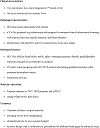A Contemporary Approach to Diagnosis and Treatment of Combined Hepatocellular-Cholangiocarcinoma
- PMID: 33415066
- PMCID: PMC7785105
- DOI: 10.1007/s11901-020-00556-4
A Contemporary Approach to Diagnosis and Treatment of Combined Hepatocellular-Cholangiocarcinoma
Abstract
Purpose of review: To provide updates on terminology, epidemiology, diagnosis, and treatment of combined hepatocellular-cholangiocarcinoma (cHCC-CCA).
Recent findings: cHCC-CCAs are tumors that in the same nodule contain a variable degree of HCC and CCA components with a transition zone. cHCC-CCAs develop in cirrhotic and non-cirrhotic livers like and is associated with poor outcomes. Mutations in TP53, TERT promoter, and ARID1A are the most common genetic aberrations in cHCC-CCA. Fusion gene PTMS-AP1G1 is unique for cHCC-CCA. A biopsy is required for diagnosis. Surgical resection remains treatment of choice, while liver transplantation for early cHCC-CCA is associated with favorable outcomes. Gemcitabine-based therapy shows benefits for advanced cHCC-CCA.
Summary: cHCC-CCAs are a heterogeneous group of primary liver cancers with unique biological behavior. Multicenter studies are required for a molecular analysis to inform novel therapeutic approaches, and understand epidemiology and benefits of liver transplantation, liver-directed and targeted therapies for this rare aggressive cancer.
Keywords: genetic aberrations; liver transplantation; loco-regional therapy; mixed liver cancer; primary liver cancer.
Conflict of interest statement
Conflict of Interest Olga Raevskaya, Henry Appelman, and Natalita Razumilava declare that they have no conflict of interest
Figures


Similar articles
-
Update on the Diagnosis and Treatment of Combined Hepatocellular Cholangiocarcinoma.J Clin Transl Hepatol. 2024 Feb 28;12(2):210-217. doi: 10.14218/JCTH.2023.00189. Epub 2023 Nov 15. J Clin Transl Hepatol. 2024. PMID: 38343605 Free PMC article. Review.
-
Combined Hepatocellular-Cholangiocarcinoma: An Update on Pathology and Diagnostic Approach.Biomedicines. 2022 Jul 29;10(8):1826. doi: 10.3390/biomedicines10081826. Biomedicines. 2022. PMID: 36009374 Free PMC article. Review.
-
Comprehensive analyses of the clinicopathological features and genomic mutations of combined hepatocellular-cholangiocarcinoma.Hepatol Res. 2024 Jan;54(1):103-115. doi: 10.1111/hepr.13965. Epub 2023 Sep 29. Hepatol Res. 2024. PMID: 37699724
-
Multi-Center Analysis of Liver Transplantation for Combined Hepatocellular Carcinoma-Cholangiocarcinoma Liver Tumors.J Am Coll Surg. 2021 Apr;232(4):361-371. doi: 10.1016/j.jamcollsurg.2020.11.017. Epub 2020 Dec 13. J Am Coll Surg. 2021. PMID: 33316425 Free PMC article.
-
Combined hepatocellular-cholangiocarcinoma derives from liver progenitor cells and depends on senescence and IL-6 trans-signaling.J Hepatol. 2022 Dec;77(6):1631-1641. doi: 10.1016/j.jhep.2022.07.029. Epub 2022 Aug 18. J Hepatol. 2022. PMID: 35988690
Cited by
-
Clinicopathological characteristics and prognosis of combined hepatocellular cholangiocarcinoma.BMC Cancer. 2024 Oct 7;24(1):1232. doi: 10.1186/s12885-024-12970-8. BMC Cancer. 2024. PMID: 39375615 Free PMC article.
-
Case Report: Long lasting response with TKI for combined hepatocellular-cholangiocarcinoma.Front Oncol. 2025 Mar 18;15:1459705. doi: 10.3389/fonc.2025.1459705. eCollection 2025. Front Oncol. 2025. PMID: 40171268 Free PMC article.
-
A Case of Combined Hepatocellular-Cholangiocarcinoma Diagnosis and Treatment With Literature Review.Clin Case Rep. 2025 Aug 13;13(8):e70652. doi: 10.1002/ccr3.70652. eCollection 2025 Aug. Clin Case Rep. 2025. PMID: 40809514 Free PMC article.
-
Update on the Diagnosis and Treatment of Combined Hepatocellular Cholangiocarcinoma.J Clin Transl Hepatol. 2024 Feb 28;12(2):210-217. doi: 10.14218/JCTH.2023.00189. Epub 2023 Nov 15. J Clin Transl Hepatol. 2024. PMID: 38343605 Free PMC article. Review.
-
Combined Hepatocellular-Cholangiocarcinoma: An Update on Pathology and Diagnostic Approach.Biomedicines. 2022 Jul 29;10(8):1826. doi: 10.3390/biomedicines10081826. Biomedicines. 2022. PMID: 36009374 Free PMC article. Review.
References
-
- H.G W, Primary carcinoma of the liver. Am.J.M.Sc, 1903. 26(126): p. 403–417.
-
- Sasaki M, Sato Y, and Nakanuma Y, Mutational landscape of combined hepatocellular carcinoma and cholangiocarcinoma, and its clinicopathological significance. Histopathology, 2017. 70(3): p. 423–434. - PubMed
-
An important work providing information on genetic abbeartions in cHCC-CCAs.
-
- Moeini A, et al., Mixed hepatocellular cholangiocarcinoma tumors: Cholangiolocellular carcinoma is a distinct molecular entity. J Hepatol, 2017. 66(5): p. 952–961. - PubMed
Grants and funding
LinkOut - more resources
Full Text Sources
Research Materials
Miscellaneous
